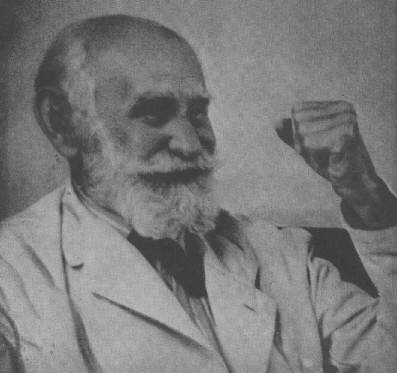
|
Excerpts from Lectures on Conditioned Reflexes, Volume II: Conditioned Reflexes and PsychiatryIvan Petrovitch PavlovCHAPTER XLVIEXPERIMENTAL NEUROSES(Read in German at the First International Neurological Congress, Berne, September 3, 1931.) |
NEUROSES IN DIFFERENT TYPES – EFFECT OF CASTRATION – ANALOGY WITH HUMAN NEUROSES.
AS NEUROSIS we understand a chronic deviation of the higher nervous activity, lasting weeks, months, and even years. For us the higher nervous activity is manifested chiefly in the system of conditioned positive and negative reflexes to any stimulus and partially, but to a lesser degree, in the general behaviour of our animals (dogs). The factors which have produced neuroses in our animals are: first, stimuli too strong or too complex; secondly, a strain of the inhibitory process; thirdly, collision (direct consequential) of the two opposing nervous processes; fourthly and finally, castration.
Neuroses are expressed in a weakening of both processes separately or together, in chaotic nervous activity, and in various phases of the hypnotic state. Different combinations of these symptoms give entirely distinct pictures. Whether or not the animal breaks down and in what form depends upon the type of nervous system.
On the basis of our investigations we found three main types. The central type is the ideal normal type in which both opposing nervous processes exist in equilibrium. This type is represented in two variations: the calm stable animal, and on the contrary the very lively ones, There are two other extreme types: one strong, even too strong but not completely normal, because the inhibitory process is comparatively weak; and the other, a weak type in which both processes are weak but especially the inhibitory one. Our classification of types more nearly coincides, it seems to me, with the classical Hippocratic grouping of temperaments.
For the sake of brevity I shall mention only a few examples of our latest experiments on castrated animals. In animals of the central type the evident disorder continues generally only some months after castration; later the animal behaves normally. Only under increased excitability was it possible to be convinced that the functional ability of the cortical cells had suffered. The excitability in the case of the food conditioned reflexes is easily changed by different degrees of hunger.
In some individuals of the strong type the evident pathological state after castration continues for many months, for years and longer, and improves only very gradually. In such animals there is a sudden temporary return to normal brought about by interrupting our experiments or giving bromides. During the daily work the conditioned reflexes are chaotic. An interruption of three days between experiments restores the reflexes to normal. The fact that each one of our experiments represents a serious work for the nervous system is thus evident. The normal activity is restored and preserved during the daily experiments by bromide therapy.
Unexpectedly and very peculiarly difficulties appeared during this régime. Ordinarily the more or less strong types directly after castration show a lowered function of the nervous system; the positive conditioned reflexes decrease. The opposite is true of the weak type; the conditioned reflexes become greater for several weeks after castration. A marked weakness of the cortical cells appears only later; in this case bromides, instead of helping, make the situation worse. This extraordinary fact can also be satisfactorily explained, but I cannot now stop to give details.
I must conclude. To make analogies between the neurotic state of our dogs and the various neuroses of man is to me, a physiologist not thoroughly acquainted with human neuropathology, a problem hardly attainable. But I am convinced that the decision, or the conditions favourable to a decision, of many important questions of etiology, the natural systematisation, the mechanism and finally the treatment of neuroses in the human being lies in the hands of the animal experimenter.*
Therefore the main purpose of my participation in the present Congress is to recommend heartily to the neuropathologists the work with normal and pathological conditioned reflexes.
* Several of these points have now I think received confirmation from the clinical side. Producing artificially in our dogs a deviation of the higher nervous activity we saw examples of difficult nervous problems in dogs of different types of nervous system, two separate forms of nervous disorder, two different neuroses.
In dogs of the excitatory and strong type, the neurosis consisted in almost complete disappearance of the inhibitory reflexes, i.e., a marked weakening almost to zero of the inhibitory process. In the other, the inhibitory and weak dogs, all positive conditioned reflexes vanished and the dog became very drowsy. In this neurosis the first dogs quickly recovered under bromides. In the second type the dogs became rapidly worse with bromides, and recovery was very slow, and was possible only with an interruption of the experiments.
Unacquainted with clinical neuroses we erroneously began, although guided by several considerations, to call the neurosis of the first dogs neurasthenic, and of the second group hysteria. Later we found the neurosis of the first dogs more similar to hypersthenia, and to call the neurosis of the second group neurasthenia, reserving the term hysteria as probably better for disturbances of the nervous system from other causes, manifested now in our experiments.
At this Neurological Congress, Dr. L. Szondi concluded that the present clinical form of neurasthenia should be separated into two neuroses, related to two opposite constitutions corresponding, in my opinion, to our above neuroses.
Ivan Petrovitch Pavlov, Lectures on Conditioned Reflexes, Volume II: Conditioned Reflexes and Psychiatry, translated and edited by W. Horsley Gantt, Lawrence & Wishart Ltd., London 1941.